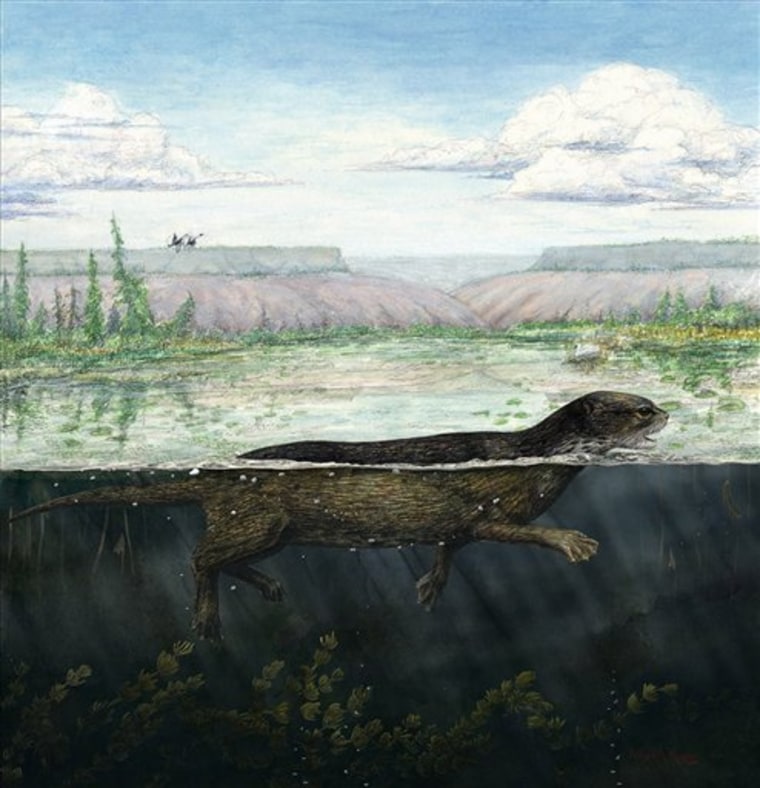Scientists say they've found a "missing link" in the early evolution of seals and walruses — the skeleton of a web-footed, otter-like creature that was evolving away from a life on land.
Those feet and other anatomical features show an early step on the way to developing flippers and other adaptations for a life in the sea, the scientists said.
One expert called it "a fantastic discovery" that fills a crucial gap in the fossil record.
The 23 million-year-old creature was not a direct ancestor of today's seals, sea lions and walruses, a group known collectively as pinnipeds. It's from a different branch. But it does show what an early direct ancestor looked like, said researcher Natalia Rybczynski.
The fossil was found on Devon Island in the Canadian Arctic, bolstering the notion that the far north was an early center of pinniped evolution, she said.
Rybczynski, a researcher at the Canadian Museum of Nature in Ottawa, and colleagues from the United States report the find in Thursday's issue of the journal Nature.
They named the creature Puijila darwini ("pew-YEE-lah dar-WIN-eye"). That combines an Inuit word for "young sea mammal," often a seal, with an homage to Charles Darwin. The famed naturalist had written that a land animal "by occasionally hunting for food in shallow water, then in streams or lakes, might at last be converted into an animal so thoroughly aquatic as to brave the open ocean."
Scientists already knew that pinnipeds evolved from land animals. But the earliest known fossil from that group already had flippers. So Puijila shows an earlier stage of evolution, the researchers said.
Puijila measured about three feet from its snout to the tip of its long tail. It resembled a river otter but had a short snout, large eyes and a thinner tail, Rybczynski said. It could hunt on land or in water, where it was apparently "a pretty darned good swimmer," she said.
The fossil was discovered in sediments of what had been a lake when the Arctic was much warmer, showing Puijila was at home in fresh water as well as on land. Besides eating fish, it probably ate rodents and ducks with dog-like teeth set in powerful jaws, Rybczynski said.
Annalisa Berta, a biology professor at San Diego State University who wasn't involved in the work, welcomed the find.
"This is a fantastic discovery that fills a critical evolutionary gap (from) when terrestrial carnivores traded limbs for fins and moved from land to sea," she wrote in an e-mail.
Apart from the poorly preserved ribs, researchers recovered about 65 percent of the skeleton. Berta said this completeness will help scientists sort out the order in which key pinniped features appeared.
Puijila's fossilized remains were found in 2007 and 2008. Its Arctic location was "completely unexpected" because most scientists believed pinnipeds evolved on the west coast of North America, Rybczynski said. The discovery lends some credence to a hypothesis that the Arctic was an early center for these mammals' evolution, she said.
Not all experts agreed. Maybe Puijila arrived in the Arctic from elsewhere, finding an area where its competitors could not survive, said Tom Demere, curator of paleontology at the San Diego Natural History Museum.
He noted that an older fossil that the study authors consider a pinniped had been discovered in Mongolia. (That fossil included only head and jaw remnants and so its body features are not known).
So the new evidence for Arctic evolution is "inconclusive at best," he said.
But Demere, who didn't participate in the Nature paper, called the discovery exciting because it provides direct evidence for what early pinnipeds in the land-to-water transition looked like.
